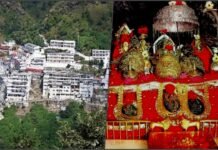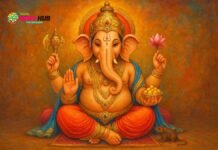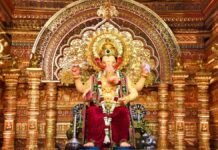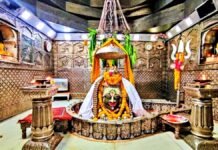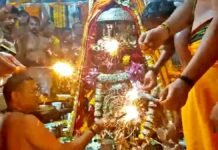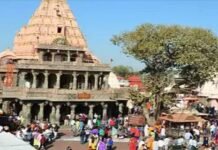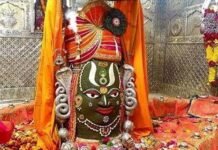
Key Points
- Bhasma Aarti, the iconic ash ritual, was performed at Mahakaleshwar Temple, Ujjain, on the first Monday of the holy month of Saavan, drawing thousands of devotees.
- The ceremony began with the traditional Panchamrit Abhishek and was accompanied by Vedic chants, conch shells, and devotional hymns.
- Saavan is considered the most auspicious month for Lord Shiva worship, with Mondays (Somwar) holding special significance for devotees.
- Witnessing the Bhasma Aarti is believed to bring spiritual purification, blessings, and liberation from worldly attachments.
- The temple, one of the twelve Jyotirlingas, becomes a hub of devotion and spiritual fervor during Saavan, attracting pilgrims from across India and abroad.
Ujjain: On July 14, the first Monday of the holy month of Saavan, the Mahakaleshwar Jyotirlinga Temple in Ujjain witnessed the revered Bhasma Aarti a unique and ancient ritual where Lord Shiva is adorned with sacred ash (bhasma) before sunrise. The ceremony began with the ceremonial bathing of the Shiva Lingam, known as the Panchamrit Abhishek, using milk, curd, ghee, honey, and fruits. This was followed by the offering of the sacred ash, symbolizing the impermanence of life and the path to spiritual enlightenment.
The temple resonated with Vedic chants, the sound of conch shells, bells, and the collective devotion of thousands of worshippers. Devotees queued from the early hours to witness the spectacle, seeking blessings and spiritual upliftment as Saavan, the most beloved month of Lord Shiva, commenced.
Significance of Bhasma Aarti and Saavan
- Symbolism of Ash: The use of bhasma (ash) in the aarti represents the transient nature of the physical world and the eternal nature of the soul. It serves as a reminder to shed ego and worldly attachments, striving for spiritual wisdom and liberation (moksha).
- Spiritual Importance: Witnessing or participating in the Bhasma Aarti is believed to purify the mind and soul, remove obstacles, and bring devotees closer to Lord Shiva’s divine presence.
- Saavan Rituals: The month of Saavan is marked by fasting, chanting of Shiva mantras, singing devotional bhajans, and performing Rudrabhishek (ceremonial bathing of the Shiva Lingam). Mondays are especially auspicious, with devotees observing strict fasts and offering prayers for peace, prosperity, and relief from troubles.
Rituals and Atmosphere at Mahakaleshwar Temple
| Ritual Step | Description |
|---|---|
| Panchamrit Abhishek | Bathing the Shiva Lingam with milk, curd, ghee, honey, and fruits |
| Offering of Bhasma | Application of sacred ash to the Lingam, accompanied by Vedic mantras |
| Devotional Chants | Recitation of hymns, ringing of bells, and blowing of conch shells |
| Devotee Participation | Long queues and collective prayers from early morning hours |
The temple’s sanctum sanctorum is filled with the fragrance of incense and the reverberation of mantras, creating an atmosphere charged with spiritual energy and devotion.
Why Saavan and Bhasma Aarti Matter
- Mythological Roots: Saavan is celebrated as the holiest month for Shiva devotees, believed to be especially dear to Lord Shiva. Worship during this period is said to grant relief from life’s troubles and fulfill heartfelt wishes.
- Pilgrimage and Community: Mahakaleshwar, as one of the twelve Jyotirlingas, becomes a focal point for pilgrims seeking blessings, spiritual cleansing, and a deeper connection with the divine.
The Bhasma Aarti at Ujjain’s Mahakaleshwar Jyotirlinga on the first Monday of Saavan is not just a ritual it’s a profound spiritual experience that draws devotees into the heart of Hindu tradition. As the sacred ash is offered and prayers fill the air, the faithful are reminded of life’s impermanence and the promise of divine grace.



















